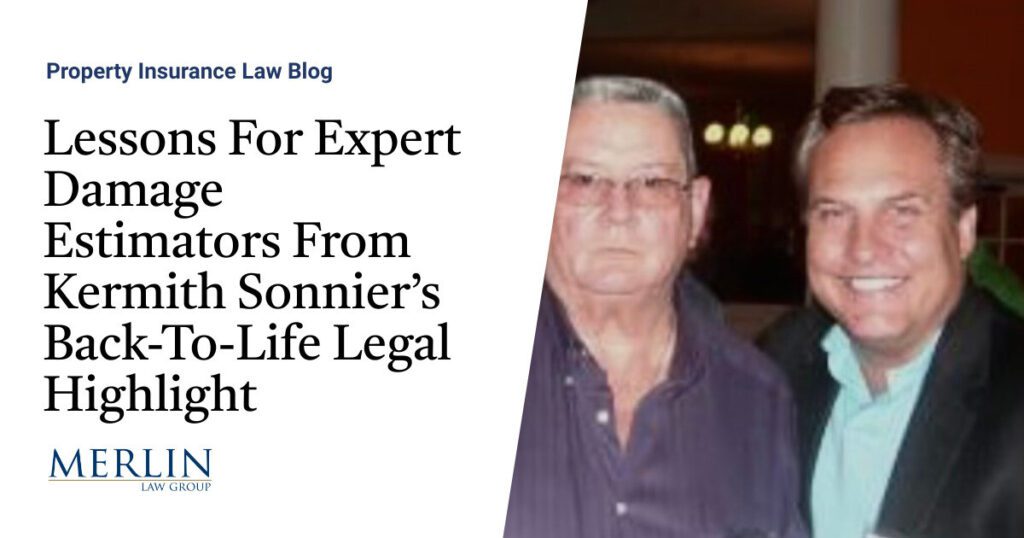Lessons For Expert Damage Estimators From Kermith Sonnier’s Back-To-Life Legal Highlight

I thought my last blog mentioning my friend Kermith Sonnier would be Public Adjuster Kermith Sonnier Passes. The Fifth Circuit Court of Appeals changed that with an extensive discussion of Kermith’s expert damages testimony and opinions in the case analyzed in yesterday’s post, Church Mutual Prevails in Latest Hurricane Laura Bad Faith Case: Key Differences and Lessons Learned.
Church Mutual attempted to disqualify Kermith Sonnier as an expert witness by citing a ruling in a case from 2012, AWM Sports d/b/a The Athletes Foot v. State Farm Fire and Casualty Company, where a Magistrate Judge had excluded Sonnier’s testimony due to flawed methodology. This highlights a crucial lesson for all expert witnesses: Your track record of prior testimony and admissibility rulings can significantly impact your credibility and future opportunities to testify. In fact, a single ruling against the admission of an expert’s testimony can potentially end their career as an expert witness.
The recent First United case1 demonstrates the critical importance of experts ensuring their methodologies and work quality in federal court meet the highest standards. Attorneys will meticulously scrutinize an expert’s past performance and methods, looking for any weaknesses that could be used to challenge their admissibility in future cases. For experts, maintaining a consistent record of sound methodology and admissible testimony is essential to long-term success in the field.
What did Kermith Sonnier do in preparing his damages estimate? The court’s opinion and briefing noted the following:
He used Xactimate software to prepare his damage estimate, which he testified is the industry standard used by about 95% of insurance companies.
He personally inspected the property inside and out and observed the damage included in his estimate.
He met onsite with the church pastor and First United’s engineer.
He and his staff spent four days on the property to scope out the damages.
They reviewed 670 photographs of the property taken by Church Mutual’s adjuster before any repairs were made.
He consulted with First United’s engineer, Robert Wright, as he was preparing his report, including 4-5 conversations to ensure everything included was properly attributed to hurricane damage.
He reviewed Wright’s engineering report before completing his estimate.
His final Xactimate estimate itemized damages totaling $1,771,741.98, broken down by building.
When questioned at trial, he acknowledged an error in the scaffolding cost input in his Xactimate estimate, resulting in a reduction of $52,459.70.
I often teach that estimators who spend more time at the loss site and speaking with people familiar with the building usually have better quality estimates of damage. How does one come up with an actual cash value part of an estimate without speaking to and learning about the condition of the building before the loss? Many property insurance estimators are in a rush to finish their jobs and often come to the wrong conclusions because they simply do not spend enough time on site and virtually no time determining the pre-loss condition and history of the building components.
The policyholder’s brief noted that Church Mutual did not object to Sonnier’s qualifications as an expert. His methodology using Xactimate and his thorough on-site inspection and review of evidence were cited by the trial court as reasons for accepting his testimony. The court accepted Sonnier’s testimony primarily because:
His methodology (using Xactimate) was industry-standard and accepted.
He conducted a thorough on-site inspection and review of evidence.
His task was to provide a damage estimate, not opine on claims handling.
Church Mutual failed to properly challenge his expertise via a timely Daubert motion.
Church Mutual did not provide evidence or testimony contradicting Sonnier’s methods. Indeed, it did not object to the admission of his expert report.
Church Mutual’s failure to file a timely Daubert motion to exclude Sonnier’s testimony was a critical misstep. While the court still considered their objections, this serves as a reminder to all attorneys: Don’t wait until trial to challenge an expert’s qualifications or methodology. Pre-trial challenges are the better practice, absent strong tactical reasons for deciding not to do so.
Kermith Sonnier’s work in this case demonstrates that being a successful expert witness is about more than just knowledge – it’s about thorough preparation, using accepted methodologies, and clearly defining your role. As we remember Kermith’s contributions to the property insurance field, let’s take these lessons from him and this case.
Thought For The Day
Before anything else, preparation is the key to success.
—Alexander Graham Bell
1 First United Pentecostal Church v. Church Mut. Ins. Co., No. 23-30779, 2024 WL 4511240 (5th Cir. Oct. 17, 2024).



